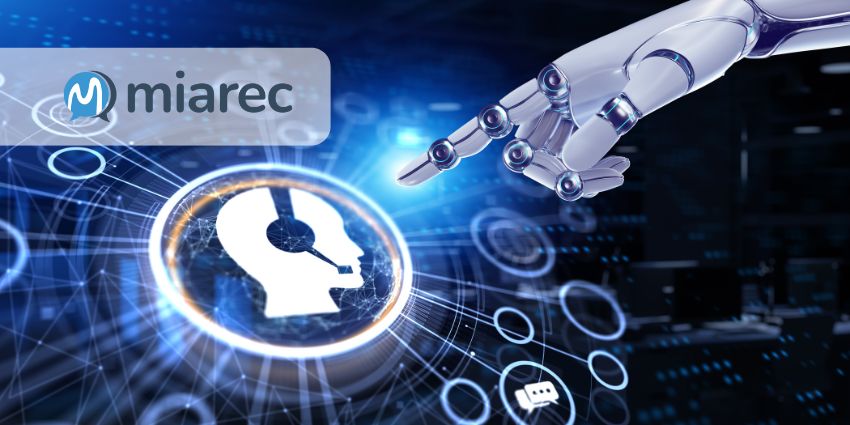What is a chatbot?
At a basic level, chatbots are computer programs capable of simulating and processing human conversation. They allow human beings to interact with machines and digital devices as though communicating with real people.
While chatbots aren’t suitable for every customer interaction, they can support a variety of use cases. Customers today use bots for everything from finding the right product on an e-commerce store to troubleshooting common problems.
The global chatbot technology market is expected to reach $4.9 billion by 2022, growing at around 19.29%. However, despite the rapid evolution of chatbot technology, many people still don’t understand what chatbots are or how they work.
Here’s everything business leaders need to know about chatbots, how they work, and why they’re so beneficial in today’s world.
What Are Chatbots? What is a Chatbot?
Chatbots are computer programs designed to simulate human conversations in response to textual or spoken input. While all chatbots allow people to interact with machines and devices in a raw format, conversational bots come in many forms.
These tools can be as simple as rudimentary programs, capable of responding to queries in a structured format, using FAQ and knowledgebase data. They can also be as complex as highly advanced conversational or generative AI tools. Recently, the hype around ChatGPT and similar devices have accelerated interest in chatbot technology for contact centers.
Generative tools can utilize context, machine learning, and significant language models to create highly personalized experiences for every user.
Though they may seem nascent, chatbots are becoming increasingly commonplace. More than 1.5 billion people are using chatbots worldwide, and adoption continues to grow.
How Do Chatbots Work?
On a basic level, chatbots process data input by a human user to respond to a query or request. Over the years, the technology has evolved. These systems can process complex data and create intuitive responses using AI algorithms.
In the past, most chatbots were text-based solutions driven by specific rules. Companies pre-programmed bots to respond to a limited set of simple queries. They were essentially interactive FAQs, only capable of understanding limited amounts of information.
Over time, as artificial intelligence has evolved, chatbots have become more sophisticated. Modern tools utilize deep neural networks, large language models, and natural language understanding to discern the intent or need of each customer.
Modern tools can then use contextual information and advanced algorithms to create highly personalized, engaging responses to questions. Most modern bots, including those built into CRM and CCaaS tools, use machine learning to grow more advanced over time.
Some can actively predict user needs based on historical data and patterns. Others can draw information from CRMs and other integrated tools to personalize responses. Some chatbots can even deliver suggestions to customers based on their requests.
For instance, a chatbot dealing with a customer asking about their order status can provide a link to an order tracking tool or automatically transfer a customer to an agent.
Types of Chatbots: AI Bots, Virtual Agents, and More
Chatbots are a core component of the evolving artificial intelligence landscape.
As AI evolves, chatbots are also transforming with new conversational algorithms, speech-based tools, and generative abilities. Different =bots may be used for specific purposes in the customer experience (CX) industry.
Some common types of chatbots include:
Menu-Based bots
Menu-based or task-oriented bots are single-purpose programs. They use very little machine learning (ML) or natural language processing. Instead, they generate automated responses to inquiries, similar to an interactive FAQ. Traditional IVRs that transfer customers to the right agent are examples of task-oriented bots.
Keyword Recognition based Chatbots
Keyword recognition-based chatbots are slightly more complex. They can actively pay attention to customers’ words and utilize these terms to form effective responses. Keyword recognition bots work similarly to standard rules-based bots but can also have more advanced features, such as learning and optimizing reactions over time.
Hybrid bots
Hybrid chatbots combine elements of both keyword recognition and menu-based models. Some hybrid bots can also leverage advanced features like natural language processing and machine learning to deliver specific responses.
Contextual chatbots
Contextual or data-driven chatbots, otherwise referred to as virtual assistants or digital assistants, are more sophisticated. They can consistently use natural language understanding and machine learning to remember conversations and deliver personalized experiences. Some solutions can use predictive intelligence and analytics to learn a user’s preferences and anticipate their needs over time.
Voice-enabled bots
Voice-enabled bots, or conversational AI chatbots, use spoken dialogue from users as input for questions or creative tasks. Developers create these bots using voice recognition APIs and text-to-speech recognition tools. Well-known examples include Amazon Alexa and Apple Siri.
Generative AI chatbots
Generative AI bots are perhaps the most advanced type of chatbot on the market today. They use large language models, deep neural networks, and more to create genuinely humanized experiences. Generative AI bots can respond to various input types, from voice to text and images. ChatGPT is an excellent example of a generative AI bot.
Examples of Chatbots: Chatbots in the CX World
Today, chatbots are common on e-commerce platforms, customer-facing websites, and corporate apps. Currently, two-thirds of customers say they would use a chatbot to solve their issues or answer common questions instead of talking to an agent.
Initially, chatbots were created as a tool for digitizing the customer experience. They help to alleviate the pain points customers often encounter online. For instance, buyer expectations for quick, personalized digital experiences have increased by 26% since 2020. Chatbots help to address this need, creating a more advanced self-service experience for users.
Primarily, bots allow companies to connect with customers in a personalized way, offering 24/7 service without expense. Bots can answer and ask questions, complete forms, generate reports, and even automate simple actions.
Companies can also develop specialized bots for specific purposes. In retail, bots can help customers choose the right products, track orders, and resolve problems. In the financial landscape, bots can assist with repetitive tasks like checking banking information.
Even ChatGPT, one of the most exciting AI assistants in the world today, is an example of a chatbot.
The Role of AI and Data in Chatbot Development
As mentioned above, different types of chatbots rely on various technologies. However, no matter how simple or complex a bot is, its functionality will be defined by data and AI.
Artificial intelligence is the component within chatbot technology that allows these tools to take action and understand information. AI is excellent for automating mundane tasks, processing data, and handling human input—the more advanced the AI in the bot, the more it can accomplish.
For instance, a generative AI bot with access to large language models, deep neural networks, and machine learning can deliver a more personalized customer experience. On the other hand, a chatbot with limited AI capabilities may only be able to generate responses to basic queries.
All chatbots also rely on access to data harnessed from various sources. As long as the data available is high in quality, the chatbot should be able to accomplish its specific tasks.
Even if the quality of the data used to train a chatbot is ideal, the bot’s functionality might suffer if it can’t collect and utilize data in the future with machine learning. Chatbots are only as good as the data they can access.
What Is a Chatbot Used For?
Chatbots are incredibly versatile tools, suitable for a range of use cases. Bots are a valuable CX resource initially designed to reduce the friction in customer digital experiences. They allow companies to rise to meet the expectations of their evolving audience.
Bots ensure companies can deliver 24/7 personalized service to every customer, on their preferred channels, from voice to messaging apps. Chatbots are becoming a core component of many contact center platforms in today’s world, obsessed with self-service and CX efficiency.
Leading vendors from RingCentral to Genesys, NICE, and many others have all developed their own chatbot technologies. Some are even investing in versions of ChatGPT-style bots.
Some of the most common uses for chatbots include:
Improving Customer Loyalty and Experience
Today’s customers want access to 24/7 consistent service across all channels. One study by Accenture found 83% of “lost customers” would have stayed with their previous provider if they had access to better customer support.
Chatbots can deliver exceptional opportunities to engage and nurture customers throughout the entire purchasing journey. They can manage interactions 24/7, proactively reach out to customers, and provide personalized interactions. They also operate on various channels, providing a consistent omnichannel service strategy.
Reducing Costs and Improving Operational Efficiency
Adhering to customer demands 24/7 personalized service isn’t easy. Customer service departments often struggle to meet unpredictable changes in demand. However, a chatbot can address this problem. Chatbots can provide a new line of support to customers and supplemental support to agents during peak periods.
Not only do bots help companies save money by reducing the need to hire additional service reps or outsource tasks, but they can also improve efficiency. To reduce roadblocks, bots can automate repetitive tasks, such as call wrap-ups and summarizations. Bots are essential in a world where 42% of customer service leaders expect demand to grow, but only 36% can expand headcount42% of customer service leaders expect the market to grow, but only 36% can expand headcount; bots are essential.
Generating Leads and Engagement
Chatbots can be valuable tools for lead generation. Proactive bots can reach out to customers browsing a website or app. They can even offer personalized suggestions on which products to buy, leveraging data from each customer profile.
Bots can also guide customers through the initial stages of the customer journey, providing advice and answering questions. They can increase customer trust in a company and reduce the risk of cart abandonment and lost sales.
Enhancing Team Performance
Chatbots aren’t just excellent tools for improving customer experience; they can also boost agent experience. Bots can be programmed to troubleshoot and automatically address problems faced by employees when using specific tools. They can help route customers to the right agent, reducing transfer rates and even surface relevant information for an agent during a conversation.
Bots can also address repetitive tasks on behalf of employees. They can provide system status updates, notify team members of impending issues, and automate certain parts of the workflow.
Increasing Sales and Opportunities
Increasingly, companies are investing in bots to generate new opportunities and sales. 55% of online shoppers abandon a purchase when they can’t quickly find an answer to a question. Bots can address this problem and even proactively recommend products to customers.
They can offer up-sell and cross-selling options to specific customers based on their interests. Plus, bots can gather valuable data to drive the company’s growth. They can offer insights into the customer journey, purchasing decisions, and market trends. Some tools can expand geographical opportunities by automatically translating content into different languages.
Are Chatbots Bad? The Challenges of Using Chatbots
Bots can deliver exceptional benefits to business leaders but suffer from some challenges. Each new technology a business introduces has risks and threats to overcome.
Companies may need to train team members to use bots effectively or work with developers to create more advanced automation flows. There’s also a risk that some chatbots may not be able to understand specific terms used by different kinds of customers. This means companies need to invest in extensive training and optimization.
Perhaps the biggest challenges facing chatbot technology include the following:
- Training effective bots: Extensive training ensures bots don’t misinterpret messages, use bias in customer conversations, and miss opportunities. Chatbots must be effectively designed, enhanced with the right technology, and properly maintained.
- Customer satisfaction: While bots can improve customer experiences in many circumstances, there’s still a need for human interactions. Bots still don’t have the empathy or creativity of human agents, which means humans need to stay in the CX equation.
- Security and privacy: Chatbots thrive on data. Collecting personal data can help to make bots more effective. However, companies must be cautious about the information they use to train their bots. Compliance with data security standards is essential.
The Future of Chatbots
Chatbots can be a fantastic addition to your business strategy. The technology behind innovative bots in today’s world is growing increasingly impressive. The rise of generative AI, conversational AI, and new machine learning models and algorithms is driving a new future for chatbots.
The evolution of complementary technologies for automation and connectivity is also influencing bots. Going forward, chatbots, like other AI solutions, are set to significantly enhance human capabilities in the CX world.
Increasingly, vendors in the contact center, CRM, and other accompanying markets are investing in new ways to make their bots ever more compelling. We’ve even seen the rise of more AI-focused contact centers in recent years, such as the Google AI contact center with an integrated generative AI chatbot builder.
Of course, like any CX technology, bots need to be implemented with caution. Companies should look for ways to enhance, not replace, their existing contact center staff members and self-service solutions. They’ll also need to ensure they’re committed to training bots effectively and monitoring outcomes with the right analytics.
With the right strategies, chatbots can become valuable to the CX landscape. The key to success is welcoming AI into the contact center with a careful, secure, and innovative approach.
FAQ
What is a chatbot used for?
Chatbots are simple AI tools designed to help companies efficiently perform routine tasks like interacting with customers. They can automate repetitive tasks, provide personalized customer recommendations, answer questions, and guide employees.
How can companies choose the right chatbot platform?
The key to choosing an effective chatbot solution is planning. Business leaders need to determine what customer service issues they want to resolve, which channels they want to use their bots on, and what type of chatbot technology they want to use.
What are the benefits of a chatbot?
Chatbots can automate tasks like customer support, sales, and marketing. They can also allow businesses to interact with customers 24/7. Bots can guide customers through the purchasing journey, assist agents in delivering personalized services, and increase sales.
What features should a chatbot have?
The best CX bots should be customizable to suit any company’s business processes. It should be able to deploy emotional intelligence, understand context, and deliver personalized experiences. It should also integrate with other contact center tools, keeping data secure.
What was the first chatbot?
The word “chatbot” first appeared in 1992. Experts believe the first chatbot created was a software program called ELIZA, developed by a professor at MIT. ELIZA could recognize critical phrases and respond with open-ended comments or questions.







